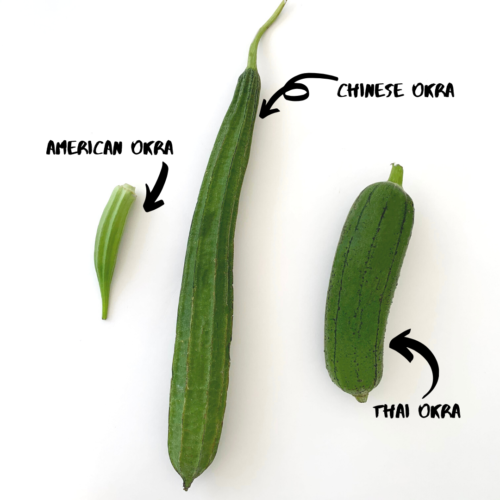Okra, Luffa, Gumbo, they’re not all the same!
Did you know that there are a few different odd-looking fruits out there with the name “okra” attached to them? Funny enough, they aren’t all technically related but named similarly because of their attributes. Here are some of the differences, similarities, and benefits of all of our favorite “okras”.
Okra
This okra is the one you probably are most familiar with. It also goes by the name “ladies’ fingers” or “gumbo” and although it has traditionally been a favorite in the Southern United States, it is growing in popularity across the whole country. This kind of okra originated in Africa (what is now known as Ethiopia) and is usually about 3-4 inches long and has a green, fuzzy, torpedo shape. The flesh is spongy with small white seeds. When cooked, it secrets a gummy substance called mucilage, making it a great thickener for stews and gumbos. It can also be fried, pickled, sautéed, stuffed, and eaten raw. Okra is an excellent source of vitamin C, and a good source of folate, magnesium and fiber.
Okra is available year-round but peak growing season in the US is during the summer months. Crystal Valley sources its okra from a variety of countries throughout the year including Guatemala, Honduras, and the Dominican Republic.
Chinese Okra
Chinese okra is a little more unique than your traditional okra and the two are actually not even related. Also known as Angled Luffa, it’s a fruit that is closely related to a cucumber, squash, and melon and the flavor is very similar to a zucchini. Typically picked when its young, Chinese okra should be about 10 inches (no more than 18) in length and its skin is dark green with hard, narrow ridges. As it matures it gets a little more fibrous and bitter and it can also be used to make sponges (or loofas).
Chinese okra is often prepared like you would a zucchini or other summer squash. It can be peeled and sliced to eat raw, fry, sauté, or steam. In Asia it is added to curries, stews, and other vegetable dishes as its spongy flesh will easily soak up flavors.
The fruit is native to India and is grown year-round in tropical climates like Florida, Honduras, and the Dominican Republic.
Chinese okra is an excellent source of vitamin C and a good source of dietary fiber, calcium and vitamin A.
Thai Okra
Thai okra is more like a Chinese okra in that it is more closely related to cucumbers and squashes. It has a leathery green skin with a spongy flesh. The fruit is also eaten immature and its versatility allows it to be used in a variety of dishes. It can be peeled and sliced to fry, sauté, or steam.
Thai okra is grown year-round in tropical and sub-tropical climates like Honduras and the Dominican Republic.
Thai okra is a good source of vitamin C and fiber.
Whichever okra you choose, we promise, they will all be good!

